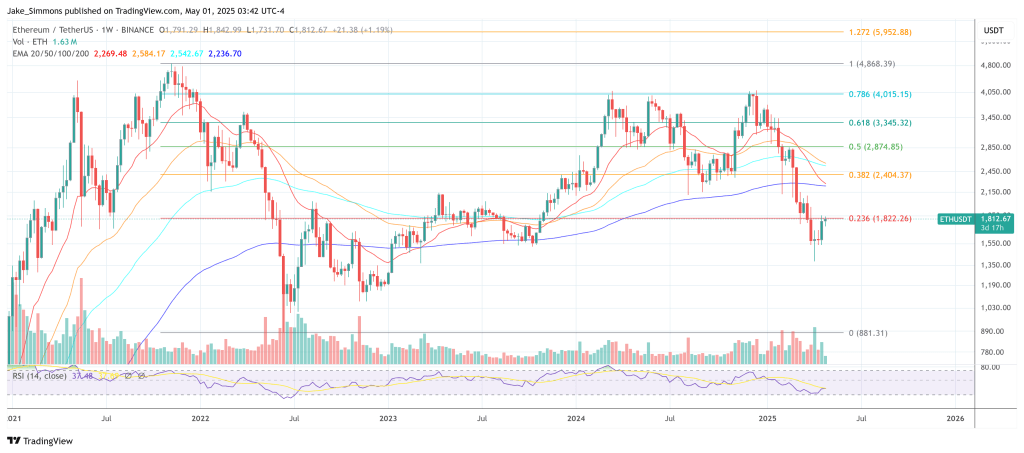Ethereum Foundation researcher Dankrad Feist has cautioned that ETH’s base layer could slip into irrelevance within a decade unless the community embraces a far more aggressive roadmap for on-chain scaling and protocol overhaul. Writing in a post on the Ethereum Magicians forum, Feist introduces a draft EIP that would pre-commit the network to a multi-year schedule of sharp gas-limit increases and complementary architectural changes.
“I do think it is time for being unconventional, because the current way of doing things is likely to make Ethereum irrelevant over the next 5-10 years,” Feist argues at the outset of his proposal.
Feist’s primary concern is strategic. He insists that the main chain must remain “the economic center of Ethereum,” warning that splintering liquidity across an expanding constellation of Layer 2 networks threatens the platform’s competitive position. “If L1 is unimportant and loses its attraction of liquidity and DeFi, there will also be less of a reason for L2s to even remain attached to Ethereum,” he writes, adding that rival ecosystems are “eager to get its market share” precisely by offering high-throughput, single-layer user experiences.
What Needs To Change For Ethereum?
On the technical front, the researcher points to rapid progress in zero-knowledge validity proofs: “Proving Ethereum L1 blocks became first possible, and is now cheap,” he notes, citing a current per-block proof cost of only a few cents via publicly available dashboards. According to Feist, the ecosystem is on track to achieve single-slot proof latency later this year, while data-availability sampling (DAS) through the PeerDAS initiative “will also become reality.” Together, these breakthroughs open the door to “100x to 1000x the current scale while keeping the most important properties: verifiability and censorship resistance.”
Feist highlights that Ethereum’s node architecture still mirrors Bitcoin’s 2009 design, asserting that it must evolve into differentiated roles—some lighter than today’s full nodes, others “beefy” builders or provers operating under a one-out-of-n honesty assumption. “The key to maintaining security and keeping Ethereum unstoppable [is] that all node types can still be run from home in some places,” he writes, referencing research calls led by Ethereum Foundation colleague Barnabé Monnot.
Historically, Ethereum governance has preferred incrementalism, but Feist contends that timidity now courts obsolescence. “Working backwards from a goal tends to have better outcomes than making incremental changes as they become possible,” he says, calling for hard-coded targets rather than open-ended deliberation. Under his outline, the forthcoming Glamsterdam upgrade would prioritise delayed execution, shorter slot times, and “aggressive history expiry.” Subsequent forks over the next two years would add parallel transaction execution, erasure-coded blocks, an enshrined zkEVM, execution payloads inside blobs, and the FOCIL mechanism to shore up censorship resistance.
Feist stresses that performance engineering must accompany consensus-layer work: “Having a concrete goal in mind will let us prioritise this work as well as the concrete upgrades as needed.” Databases and mempools optimised for a five-fold throughput increase, he reasons, could look “very different” from those designed for a hundredfold jump.
Anticipating criticism that a high-throughput roadmap would turn Ethereum into a “datacenter chain,” Feist dismisses the label as superficial. “The core value proposition of Ethereum is not the home staker, it is verifiability and censorship resistance,” he contends. While acknowledging that most users already rely on custodial RPC endpoints rather than self-run nodes, he argues that zero-knowledge proof verification will make trust-minimised usage easier, not harder. Moreover, mechanisms such as FOCIL or Minimum Censorship Proposers (MCP) could deliver “better censorship resistance than we have today.”
Feist closes by underscoring Ethereum’s “huge moat in DeFi liquidity” and insists that colocated applications still derive network effects from Layer 1 proximity. “At 100x the current scale, Ethereum L1 can support a very large range of value-transaction[s] such that competing with it simply on scaling terms is not an interesting game to play anymore,” he writes. The “endgame,” in his vision, is a base layer capable of processing orders of magnitude more activity without sacrificing the protocol’s defining guarantees.
“We need to commit to it as soon as possible, both because builders and applications need predictability, and because we need to prioritise properly so that it can actually get executed.”
At press time, ETH traded at $1,812.

Featured image created with DALL.E, chart from TradingView.com

Editorial Process for bitcoinist is centered on delivering thoroughly researched, accurate, and unbiased content. We uphold strict sourcing standards, and each page undergoes diligent review by our team of top technology experts and seasoned editors. This process ensures the integrity, relevance, and value of our content for our readers.

